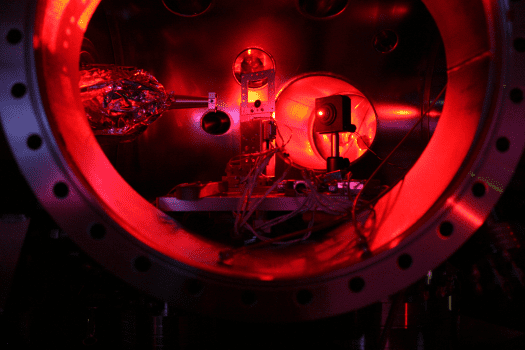
Caption of the Linac Coherent Light Source SXR experimental chamber, which was used to heat a solid material at 2 million degrees Fahrenheit, and turn it into hot, dense matter. (c) University of Oxford/Sam Vinko
Researchers at SLAC National Accelerator Laboratory have used the world’s most powerful X-ray laser fired upon a neon gas capsule and thus emit an avalanche of short wavelength X-rays,creating the first atom laser. The same laser was used to heat a lump of matter at over 2 million degrees Fahrenheit – hotter than the sun’s corona.
“X-rays give us a penetrating view into the world of atoms and molecules,” said physicist Nina Rohringer, who led the research. A group leader at the Max Planck Society’s Advanced Study Group in Hamburg, Germany, Rohringer collaborated with researchers from SLAC, DOE’s Lawrence Livermore National Laboratory and Colorado State University.
“We envision researchers using this new type of laser for all sorts of interesting things, such as teasing out the details of chemical reactions or watching biological molecules at work,” she added. “The shorter the pulses, the faster the changes we can capture. And the purer the light, the sharper the details we can see.”
The Linac Coherent Light Source, a rapid-fire X-ray laser, was configured to have its X-ray pulses knock electrons out of the inner shells of atoms of neon gas, located in a targeted capsule. When other electrons fell in to fill the gaps, about one in 50 atoms responded by emitting a photon in the X-ray range, which has a very short wavelength. Shortly after the first burst, the neighboring neon atoms are stimulated to produce X-rays at their own, and so on in a chain effect which leads to an amplification of the laser light 200 million times.
Using an atomic laser such as this, scientists can now monitor at the atomic-scale precision any changes that occurred within a few quadrillionths of a second in a studied sample. Thus it can penetrate and look at a dense solid, all the same time.
Scientists have been trying for more than 50 years to create a laser pulse at short wavelength, however this was extremely difficult until recently since it requires faster atom pumping. Until 2009, when LCLS turned on, no X-ray source was powerful enough to create this type of laser.
“This achievement opens the door for a new realm of X-ray capabilities,” said John Bozek, LCLS instrument scientist. “Scientists will surely want new facilities to take advantage of this new type of laser.”
In another separate study, the same scientists from the SLAC National Accelerator Laborator, used the powerful X-ray laser to heat an aluminum foil to 2 million degrees Celsius, or 3.6 million degrees Fahrenheit, turning it into dense, hot matter. The whole process took about a trillionth of a second. The LCLS is underground in Palo Alto and covers a distance of a little more than a mile.
This hot, dense matter is called plasma, which was reproduced in the past from gases using conventional lasers, however if want to create plasma from a solid, you need a powerful ultra-short wavelength emitting laser. By studying the plasma as it develops, the scientists hope to understand how nuclear fusion, like the one that fuels the sun, works.
Both studies were published in the journal Nature.









